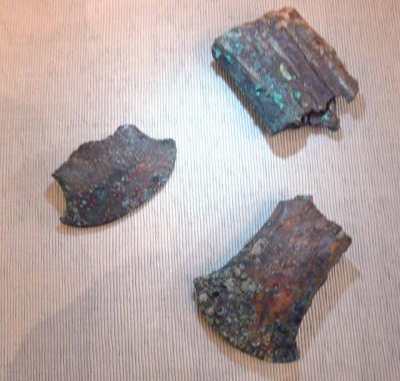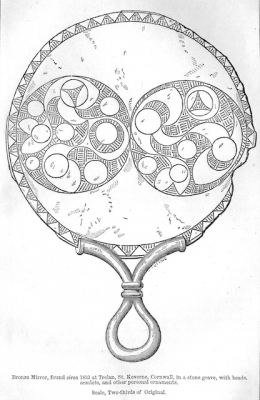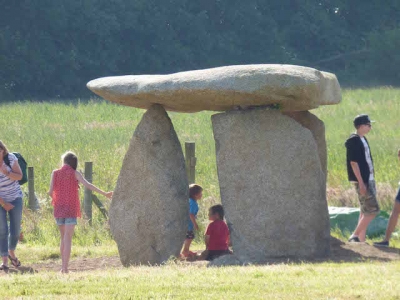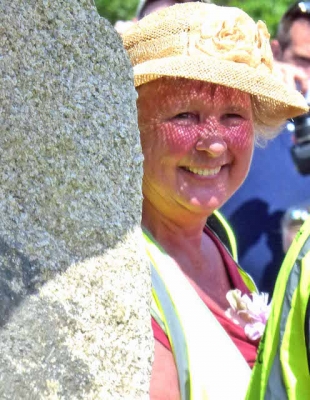The invention of the Cornish shovel made it easier to shove things into the ground. It didn’t necessarily make it much easier to retrieve them as you had to remember the right place to dig.  Underground deposits await finders as has been shown by the accidental discovery of a few hoards, right here, on The Lizard, under the noses of passers by, even closer under their feet. The likelihood of an archaeologist discovering such a hoard approaches that of a lottery win with a bleached out illegible ticket. Even retrieval by the owner never approaches the certainty of a vomiting cat’s canny foreknowledge of the footfall of the next barefoot passer by.
Underground deposits await finders as has been shown by the accidental discovery of a few hoards, right here, on The Lizard, under the noses of passers by, even closer under their feet. The likelihood of an archaeologist discovering such a hoard approaches that of a lottery win with a bleached out illegible ticket. Even retrieval by the owner never approaches the certainty of a vomiting cat’s canny foreknowledge of the footfall of the next barefoot passer by.
Hoards traditionally make themselves known to followers of horse powered implements. More recently metal detectorists have taken the lead, many of whom exercise restraint to preserve archaeological context, the value of which is paramount. Supply & demand can give a monetary value to almost anything, but the juxtaposition of artefacts in datable layers reveals history within prehistory and teases a complex story beyond the sum of its parts – a story that is repeated after the destruction that is a necessary part of excavation.
A hoard may accompany a traveller en route to another world. In a process of extending a lane at Trelan Bahow in 1833, Samuel James, a farmer, disturbed some burials laid out in stone cists, one of which contained grave goods. He emigrated, leaving some of the finds in the care of Mr Edwards who was employed by him at the time. 40 years later memories were published in The Archaeological Journal ¹ & the Trelan Mirror made its way to the British Museum. Glass beads, brass rings, bronze fibulae & stone tools were part of the hoard ².
 To the blinkered minds of archaeologists, a mirror suggests a female burial ³. The recent discovery of a grave on Scilly containing both mirror & sword has done something to derail this theory. This is a prominent problem with archaeology where a surplus of hard facts can easily disrupt a beautifully crafted tale. We are fortunate in one way not to be overwhelmed by such discoveries in the Meneage, a few pieces of metal reasonably close to the 1935 discovery of a bronze axe at Gillan falling convincingly into the category of a working smith’s hoard; coin hoards from Ruan Minor, 1670, Condurrow, 1735, Trevassack 1822 ⁷ suggest useless wealth in a non-monetary society. But a C13th charter ⁴ conveniently accessible in Latin & published in the Cartulary of St Michael’s Mount ⁵ describes shenanigans between the Abbot and a Meneage tenant in the region of Mill Mehal, thereby adding legitimacy to the Meneage Archaeology Group’s purview of the Mount itself whereat was recently discovered a bronze hoard sufficient to add tortuous legitimacy to this article by extension of MAG’s flexible boundary.
To the blinkered minds of archaeologists, a mirror suggests a female burial ³. The recent discovery of a grave on Scilly containing both mirror & sword has done something to derail this theory. This is a prominent problem with archaeology where a surplus of hard facts can easily disrupt a beautifully crafted tale. We are fortunate in one way not to be overwhelmed by such discoveries in the Meneage, a few pieces of metal reasonably close to the 1935 discovery of a bronze axe at Gillan falling convincingly into the category of a working smith’s hoard; coin hoards from Ruan Minor, 1670, Condurrow, 1735, Trevassack 1822 ⁷ suggest useless wealth in a non-monetary society. But a C13th charter ⁴ conveniently accessible in Latin & published in the Cartulary of St Michael’s Mount ⁵ describes shenanigans between the Abbot and a Meneage tenant in the region of Mill Mehal, thereby adding legitimacy to the Meneage Archaeology Group’s purview of the Mount itself whereat was recently discovered a bronze hoard sufficient to add tortuous legitimacy to this article by extension of MAG’s flexible boundary.
In case you should think hoarding only a function of the distant past, on August 3rd, 2006, the convoluted procession of 5 police cars & a helicopter in close formation with the bearer of a knapsack full of low denomination notes of the realm ⁶, thoughtlessly & unwillingly provided by a local post office, offers an example of a modern deposition.  A farm tractor carrying out its daily function of roadblocking somewhere near Gillan brought the procession to a halt. £40 unaccounted for in the subsequent reckoning still awaits discovery by some diligent opportunist, a replacement, perhaps covering the same general area whence “24 gallons” ⁷ of small copper coins of Constantine and his family (also in a knapsack) were located; &, in a ceremony of a different nature, a time capsule was inserted after the ritual resurrection of Carwynnen Quoit at Midsummer 2014, containing a small jar of local honey for finders to identify local plant species from its pollen, a golf ball, a small teddy bear and a wooden owl, the badges of Troon Cricket and Camborne Rugby clubs, a small wooden cricket bail, a crystal and a small St Christopher medal showing a car, plane, train and boat, beads and a serpentine heart along with a shell earring, a pin badge of the Cornish Flag & a sample of hair in a blue glass bottle so that future archaeologists could study DNA.
A farm tractor carrying out its daily function of roadblocking somewhere near Gillan brought the procession to a halt. £40 unaccounted for in the subsequent reckoning still awaits discovery by some diligent opportunist, a replacement, perhaps covering the same general area whence “24 gallons” ⁷ of small copper coins of Constantine and his family (also in a knapsack) were located; &, in a ceremony of a different nature, a time capsule was inserted after the ritual resurrection of Carwynnen Quoit at Midsummer 2014, containing a small jar of local honey for finders to identify local plant species from its pollen, a golf ball, a small teddy bear and a wooden owl, the badges of Troon Cricket and Camborne Rugby clubs, a small wooden cricket bail, a crystal and a small St Christopher medal showing a car, plane, train and boat, beads and a serpentine heart along with a shell earring, a pin badge of the Cornish Flag & a sample of hair in a blue glass bottle so that future archaeologists could study DNA.
 Thanks to Pip Richards for the preceding list, & for information leading to my greatest possibility for discovering a hoard. Without her efforts Carwynnen Quoit would still be a stone clearance pile in a field. She was also the force behind Sustrust & Crenver Grove. I dedicate this article to her memory.
Thanks to Pip Richards for the preceding list, & for information leading to my greatest possibility for discovering a hoard. Without her efforts Carwynnen Quoit would still be a stone clearance pile in a field. She was also the force behind Sustrust & Crenver Grove. I dedicate this article to her memory.
Meanwhile, Timeshare Cat, owned by Jane Next-Door-But-Two, has entered via a window & demanded breakfast. I find her subsequent ritual deposit without the aid of a metal detector & hop to the kitchen sink muttering a shamanic incantation.
Kyj dhe ves⁸.
¹Archaeological Journal Volume 30, Issue 1, 1873.
²The nearby Trelanvean Cross was overturned as a result of this discovery. According to the minutes of the AGM of the Royal Institute of Cornwall of November 18th 1880 “the job was done at night, by undiscovered bandits, with the view of appropriating the crock of gold which was imagined to be at its root”. Mr Richard Smith replaced the cross in its original position shortly before quitting his tenancy that Michaelmas.
³ Derrek Hines’ poem “The Trelan Mirror” assumes the female gender – Open to the Weather; Cargo Press; 1997.
⁴ Translated from the Latin by the brother of a neighbour, Father Michael Clothier of the order of St.Benedict as follows:
Charter of Thomas Polgwidnan, son of Hanmund of Wendred about moor land and waters near the leper house of Nansclegy
This testifies that, on Thursday nearest after mid-lent 1267 (31st march 1267) Thoma,(etc)and Brother Ralph then Prior of St.Michael’s Mount. Cornwall reached this agreement-Thomas gave, conceded and let go, and completely quit claimed, for himself, heirs, and assignees, to the said Ralph and his successors the whole right he had, or could have, or said he had, to the moor, waters and lands near the leper house of Nansclegy⁸ marked out as follows: the kings road past the aforesaid leper house, towards St.Keverne up to the large stone⁹ by the roadside to the south, as far as the spring near the stone, and then to the vineyard of the said Thomas. opposite St. Michael’s Mill, as far as the ford of Nansclegy along the fence posts made there. In addition, the said Thomas concedes, for and with all his heirs and assignees, to the said Prior and all his successors, all of the waters running in the said moor for them to have and to channel freely as suits them in perpetuity. In addition, the said Thomas concedes, on behalf of his heirs and assignees, to the said Prior, and his successors, full right of way to all men going to their mill with horses and pack animals, modifying the road as necessary. To be had and held freely and unhindered by the said Prior and successors in perpetuity. For this concession and remission, the said Prior concedes and remits, for himself and his successors, to the said Thomas and his heirs and assignees all right to the said garden in that particular area between the said boundaries and road up to the said stone.
In witness of this matter, here the document is sealed (wax = ciro) and settled and Prior Ralph and Thomas have placed their signatures
Witnesses: Sir Richard de Tregod, John Beaupre Joscelin de Antrenon. Ralph de Rosmeryn Reverend John Long and some others
⁵P L Hull, The Cartulary of St Michael’s Mount.
⁶ Folk memory amongst inhabitants of Tregarne who were tangentially involved in this scenario.
⁷ R D Penhallurick; Ancient and Early Medieval Coins from Cornwall & Scilly. A gallon is assumed to be 8lbs or 3.6287k.
⁸ Rude words in Cornish best left untranslated.
⁸The location of Nanclegy lazar house seems to follow a polar wandering curve10. Various authors have their theories.
⁹Speculation as to the whereabouts of the large stone may be forthcoming.
10One of the formative factors of the theory of continental drift. Palaeomagnetism, locked into cooling igneous rocks, indicates changes in the position of the Earth’s magnetic poles over time. The polar wandering curves thus described for different land masses can only be made to agree by shifting the positions of continents through time. Wegener was vindicated shortly after his death in Greenland. The relevance of this to a missing structure for which no archaeological evidence has been discovered is debatable, but it allows me to draw attention to the fact that The Lizard is one of these tectonic shards whose wandering has been interrupted by Cornwall getting in the way, the Meneage Crush Zone’s confused geology being evidence of the collision.
Published: May 2016
Author:Chris Harris, MAG
